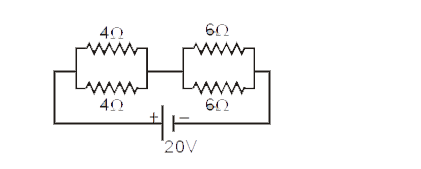The example for non- ohm ice resistance is
Copper wire
Carbon resistance
Diode
Tungston wire
The correct Answer is:C
Step by step video, text & image solution for The example for non- ohm ice resistance is by Physics experts to help you in doubts & scoring excellent marks in Class 12 exams.
Topper's Solved these Questions
- BOOK - ERRORLESS CHAPTER - CURRENT ELECTRICITYEXERCISE - Kirchhoff s Law, cells8videos
CURRENT ELECTRICITY
- BOOK - ERRORLESS CHAPTER - CURRENT ELECTRICITYEXERCISE - Different Measuring Instruments1videos
CURRENT ELECTRICITY
- BOOK - ERRORLESS CHAPTER - COMMUNICATION SYSTEMEXERCISE - S E T14videos
COMMUNICATION SYSTEM
- BOOK - ERRORLESS CHAPTER - ELECTRO MAGNETIC INDUCTIONEXERCISE - SET20videos
ELECTRO MAGNETIC INDUCTION
Similar Questions
Knowledge Check
- Question 1 - Select One
The resistance of a resistance thermometer has values 2.71 and 3.70 ohm at 10∘C and 100∘C . The temperature at which the resistance is 3.26 ohm is
A40∘CB50∘CC60∘CD70∘C - Question 2 - Select One
The temperature coefficient of resistance of a wire is 0.00125
per^∘C. At 300K, its resistance is 1 ohm. This resistance of the wire will be 2 ohm at.A1154KB1100KC1400KD1127K - Question 3 - Select One
The temperature coefficient of resistance of a wire is 0.00125 per .oC. At 300K, its resistance is 1 Ω. The resistance of the wire will be 2 Ω at
A1154 KB1100 KC1400 KD1127 K
For the circuit shown rate of heat produced in the 5 ohm resistance is 10 cal/sec. then the rate of heat produced in 4 ohm resistance will be:
 View Solution
View SolutionThe equivalent resistance of a series combination of two resistances is X ohm. If the resistance are of 10 ohm and 40 ohm respectively, the value of X will be
View SolutionFour cell each of emf 2 V and internal resistance 1 ohm are connected n parallel with an external resistance of 6 ohm. The current in the external resistance is
View SolutionIn the given circuit, the resistances are given in ohm. The current through the 10Ω resistance is 3 A while that through the resistance X is 1 A. No current passes through the galavanometer. The values of the unknown resistances X and Y are respectively (in ohm)
 View Solution
View SolutionThe SI unit of electrical resistance is Ohm which is defined as
View Solution


